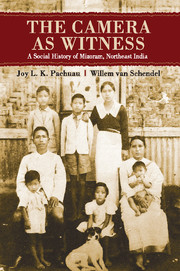Book contents
- Frontmatter
- Contents
- List of Figures
- List of Maps
- Acknowledgements
- I Becoming Mizo
- II Mizoram in the New India
- 11 The Long Goodbye
- 12 The Emergence of Popular Politics
- 13 Mizoram and the New Indian Order
- 14 Mizoram Comes to Delhi
- 15 The Search for Authenticity at Home
- 16 Mizo Style: Cowboys at Heart
- III Visions of Independence
- IV Mizo Modernities
- Copyrights and Sources
- Glossary
- Bibliography
- Index
15 - The Search for Authenticity at Home
from II - Mizoram in the New India
Published online by Cambridge University Press: 05 May 2015
- Frontmatter
- Contents
- List of Figures
- List of Maps
- Acknowledgements
- I Becoming Mizo
- II Mizoram in the New India
- 11 The Long Goodbye
- 12 The Emergence of Popular Politics
- 13 Mizoram and the New Indian Order
- 14 Mizoram Comes to Delhi
- 15 The Search for Authenticity at Home
- 16 Mizo Style: Cowboys at Heart
- III Visions of Independence
- IV Mizo Modernities
- Copyrights and Sources
- Glossary
- Bibliography
- Index
Summary
The Indian state's designation of Mizoram as ‘tribal’ had far-reaching consequences. Exposure in Delhi led to branding Mizoram for all-Indian audiences as a land of people in colourful outfits, bamboo crafts and emblematic dances (see Chapter 14). But the state was also a local actor, and in Mizoram itself, the ‘tribal’ label created its own dynamics. Local state rituals appropriated and projected cultural identities in ways that connected with ongoing discussions about modernity, tradition and spirituality. In this chapter, we look at festivals, dance and dress.
State-organized festivals
In the colonial period, church leaders in Mizoram had been cautious about the use of indigenous symbols in worship. In their opinion, modern worship should present a clear break with tradition. Over time, however, they allowed indigenous elements into church services, for example, traditional drums and hymns set to Mizo melodies. Only in the central church of the Presbyterian Church in Mission Veng (Aizawl), drums remained barred; they were not introduced in worship until the 1980s (Chapter 4). Christian-inspired revivalist movements that ‘identified their spirituality with indigenous symbols’, however, presented a persistent challenge. The leadership of the ‘mission churches’ (Presbyterian and Baptist) bemoaned this as emotionalism and excess. The Presbyterian Church even issued a book containing official guidelines discouraging emotionalism and the excesses of revivals. Church leaders were loath to see revivalists begin to form their own heterodox ‘indigenous churches’ based on a Christian spirituality that expressed itself in emphatically Mizo cultural forms.
After Independence, this interest in ‘traditional’ cultural practices overlapped with the state-sponsored classification of Mizoram's population as ‘tribal’ – and the two soon merged. The installation of the first elected Autonomous District Council in 1952 hastened the process. The council declared government holidays for three major Mizo festivals, the Chapchar Kut (Spring Festival), Mim Kut (Maize Festival) and Pawl Kut (Harvest Festival), and these began to be celebrated with state sponsorship.
These celebrations did not restore pre-Christian ceremonies. Rather, they were commemorations of former ceremonies now firmly placed within a Christian setting.
- Type
- Chapter
- Information
- The Camera as WitnessA Social History of Mizoram, Northeast India, pp. 275 - 287Publisher: Cambridge University PressPrint publication year: 2015

